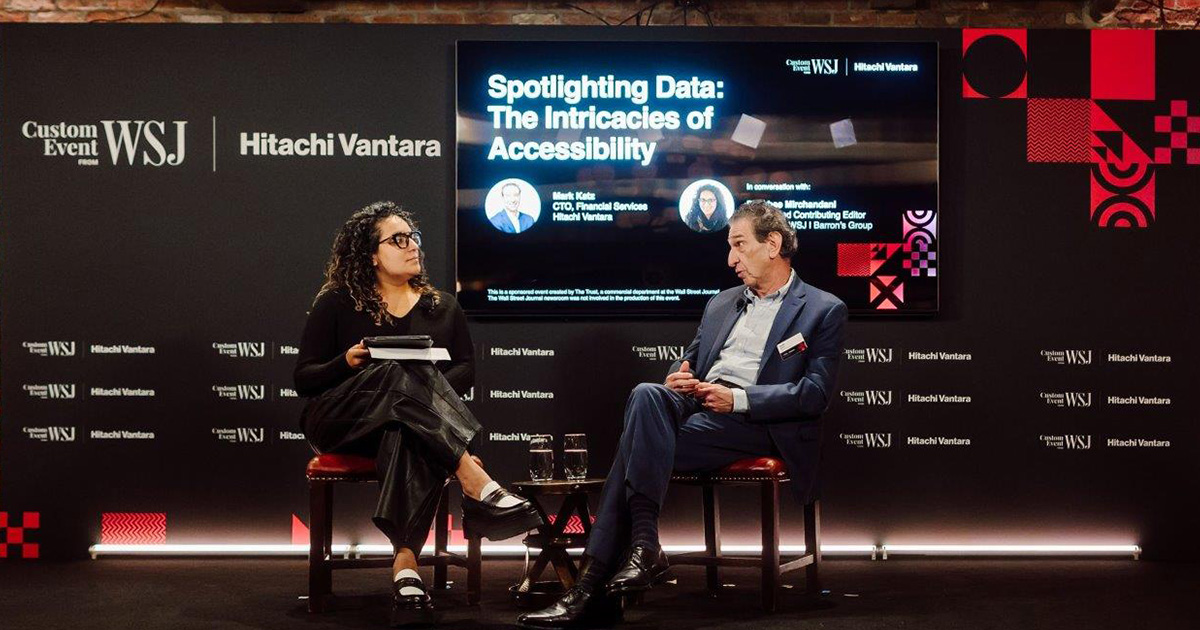How Data and AI Are Forming the Foundation for Innovation


Hitachi Exchange: Building a new blueprint for AI-driven innovation
This year, business leaders are grappling with the toughest questions we’ve faced so far in harnessing the power of AI. Now, more than ever, finding a nuanced balance among privacy, data protection, innovation, consumer trust, and internal integrity is crucial for organizational success.
Earlier this month, I was in New York at the Hitachi Vantara Exchangeopens in a new tab, where many of us gathered, ready to dive deep on all the musings, challenges, opportunities and considerations that come at a time when the world’s digital environments have never been so complex.
Hosted by The Trust, a commercial department at The Wall Street Journal, the event was a chance for many of us to not only highlight best practices but also share experiences and collect advice on everything from streamlining the cloud journey, understanding the business impact of AI integration, ensuring privacy compliance, mastering data management, to extracting valuable insights for the finance industry.
Here are my key takeaways.
Data management and architecture as the base of generative AI efforts
In a conversation between Mark Katz, the CTO of Financial Services at Hitachi Vantara and Mirchandani from The Trust, WSJ and Barron’s Group, data accessibility was a big focus. Katz set the tone, emphasizing the foundational role of data management and architecture in generative AI efforts.

According to Katz, the explosion of unstructured data means that businesses not only have to manage that data, but protect personal identifiable information with segmentation, and track lineage. As he put it, “it's not enough to simply store the data and retrieve it” – we need sophisticated data management tools across complex cloud and hybrid cloud environments to draw the right insights.
I came away with an important reminder that the digital environment is complicated, and it’s going to be a journey where “you are never really done.” It is so important to choose a technology partner that can offer the right support today as well as anticipate future needs and opportunities.
Risks and opportunities of generative AI
Striking the right balance between leveraging the capabilities and managing the risks of generative AI is delicate. Bharti Patel, SVP of Product Engineering at Hitachi Vantara, stressed the importance of focusing these efforts towards mission-critical applications. Data intelligence and infrastructure are some of the challenging areas in enterprise AI that Hitachi Vantara is trying to solve. Just as important is the consideration of varying regulations across industries, with financial services and healthcare needing particularly stringent data protection assurances in place.
Debika Bhattacharya, Chief Product Officer at Verizon Business, offered sage advice on this, stating that organizations should “experiment aggressively and implement thoughtfully.” This wisdom underscores the importance of striking a balance between being bold with the ambition while also careful and considerate with implementation to deliver the right trade off when the stakes can be so high.
A new framework for innovation
Business leaders are incorporating AI tools into daily operations now more than before, all while navigating tighter budgets and evolving regulatory requirements. Jeb Horton, SVP, Global Services at Hitachi Vantara, highlighted that enterprises are at “varying degrees of embedding AI into what they do.” Speaking on enterprise innovation in this environment, the panellists agreed that responsible AI frameworks are critical for enterprise adoption.
The discussion went on to reveal a few different takes on what was most important:
Lan Guan, Chief AI Officer at Accenture emphasised that, “Your proprietary data is your biggest advantage,” underscoring that success hinges more on the quality of that data.
Dave Malik, Cisco Fellow and CTO, Customer Experience, predicted that as more use cases of generative AI come into being, there’ll be exponential progress with broader transformation efforts. Malik stated, “Once there's trust in the system and adoption, people will be willing to take more calculated risks with new use cases.”
Andrew Chin, Head of Investment Solutions and Sciences at AllianceBernstein, pointed out that innovation must always accompany wider change and acknowledged the challenge for any organization is to adapt seamlessly. AllianceBernstein’s strategy involves integrating innovation into the cultural fabric of the organization, creating a forum for employees to engage and develop their own ideas for adoption.
Final thoughts
The reality is, organizations are navigating uncharted territories where the stakes are high and the landscape is continually shaped by technological advancements. It’s never been more important for us to lean into the innovation ecosystems around the world – starting with New York – to align on the potential, understand the risks and co-create a new blueprint for how data and AI run parallel to innovation. I’m so grateful to have spent these few days in reconnecting with colleagues and meeting so many of the best and brightest who are at the forefront of this next chapter across a number of diverse industries.
Learn how to transform your business operations with AI.